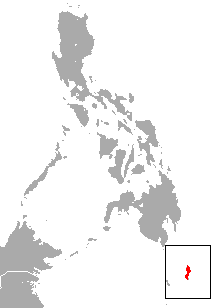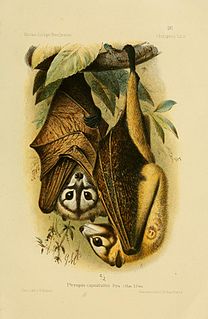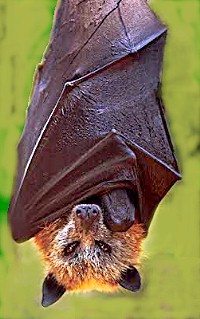
Megabats constitute the family Pteropodidae of the order Chiroptera (bats). They are also called fruit bats, Old World fruit bats, or—especially the genera Acerodon and Pteropus—flying foxes. They are the only member of the superfamily Pteropodoidea, which is one of two superfamilies in the suborder Yinpterochiroptera. Internal divisions of Pteropodidae have varied since subfamilies were first proposed in 1917. From three subfamilies in the 1917 classification, six are now recognized, along with various tribes. As of 2018, 197 species of megabat had been described.

The giant golden-crowned flying fox, also known as the golden-capped fruit bat, is a species of megabat endemic to the Philippines. Since its description in 1831, three subspecies of the giant golden-crowned flying fox have been recognized, one of which is extinct. The extinct subspecies was formerly recognized as a full species, the Panay golden-crowned flying fox. Formerly, this species was placed in the genus Pteropus; while it is no longer within the genus, it has many physical similarities to Pteropus megabats. It is one of the largest bat species in the world, weighing up to 1.4 kg (3.1 lb)—only the Indian and great flying fox can weigh more. It has the longest documented forearm length of any bat species at 215 mm (8.5 in).
Flying fox is a common name for bats of the genus Pteropus.

Pteropus is a genus of megabats which are among the largest bats in the world. They are commonly known as fruit bats or flying foxes, among other colloquial names. They live in the South Asia, Southeast Asia, Australia, East Africa, and some oceanic islands in the Indian and Pacific Oceans. There are at least 60 extant species in the genus.

The Sulawesi flying fox or Sulawesi fruit bat is a species of megabat endemic to Indonesia. It is classified as "Vulnerable" by the IUCN due to unsustainable levels of hunting.

The Talaud flying fox or Talaud fruit bat is a species of bat in the family Pteropodidae. It is endemic to the islands of Salebabu and Karekaleng in the Talaud Archipelago of Indonesia. Its natural habitat is subtropical or tropical swamps.

The Sunda flying fox or Sunda fruit bat is a species of bat in the family Pteropodidae. It is endemic to Indonesia.

The gray flying fox is a species of flying fox in the family Pteropodidae. It is not to be confused with the grey flying fox. It is found in Indonesia, but not in the Philippines, despite occasional reference to such. Very little is known about this species. The gray flying fox has small size and neutral coloration with a brownish head and an orange abdomen. It probably roosts individually or in small groups. It was listed on appendix II of CITES, and is classified as "Data Deficient" by the IUCN. This species has been decimated by hunting for bushmeat in Indonesia. The hunters use fishing hooks, ropes, and other supplies to hunt the bats. The ropes and hooks are placed along their flight paths, tearing and ensnaring the bats' wings when are flying. In the course of a hunting season, entire colonies can be killed.

The black-bearded flying fox is an endangered species of megabat in the genus Pteropus. It is endemic to Indonesia, found on the islands of Ambon, Buru, Seram, Banda, and Yamdena. Currently considered monotypic, it formerly included the Aru flying fox and Kei flying fox as subspecies.

The great flying fox, also known as the greater flying fox or Bismarck flying fox, is a species of megabat in the genus Pteropus, found throughout lowland areas of New Guinea and in the Bismarck Archipelago. Conflicting evidence suggests that its closest relative is either the spectacled flying fox or, jointly, the Pelew and insular flying foxes. Two subspecies are recognized. At up to 1.6 kg (3.5 lb) in weight, it is among the heaviest bats in the world and the largest bat in Melanesia. It is a gregarious animal which roosts with hundreds or thousands of individuals. In part due to its wide variation in color, it has many taxonomic synonyms, including Pteropus degener, Pteropus papuanus, and Pteropus sepikensis. It may forage during the day or night in search of fruit, including figs or fruits from the family Sapotaceae. It is considered a least-concern species by the IUCN, though its numbers have been negatively impacted by what appeared to be a disease, as well as by hunting for bushmeat that occurs across its range.

The Bonin flying fox, Bonin fruit bat, or in Japanese Ogasawara giant bat is a species of flying fox in the family Pteropodidae. It is endemic to four islands in Ogasawara Islands, Japan. Its natural habitat is subtropical forests. It is threatened by habitat loss.

The Vanikoro flying fox, also known locally as basapine, is a species of bat in the family Pteropodidae. It has only been found in the Vanikoro island group located in the southern Solomon Islands. The species as a whole was originally known from just a few specimens collected sometime before 1930 but following surveys conducted on the island in the early 1990s did not detect this species again causing the Vanikoro flying fox to be listed as extinct. However, the species was rediscovered by a survey conducted in late 2014 which indicated a population in the high hundreds or low thousands and reported all observations.

The large flying fox, also known as the greater flying fox, Malayan flying fox, Malaysian flying fox, large fruit bat, kalang, or kalong, is a southeast Asian species of megabat in the family Pteropodidae. Despite its scientific name, it feeds exclusively on fruits, nectar, and flowers, like the other flying foxes of the genus Pteropus. It is noted for being one of the largest bats. As with nearly all other Old World fruit bats, it lacks the ability to echolocate but compensates for it with well-developed eyesight.

The Pteropodinae are a subfamily of megabats. Taxa within this subfamily are:

The Aru flying fox is a Critically Endangered species of megabat found in the Aru Islands in Indonesia. It was described by Wilhelm Peters in 1867. It was formerly considered a subspecies of the black-bearded flying fox. The species is poorly known, and has not been encountered since the 19th century. It is classified as critically endangered by the IUCN and is listed on CITES appendix II.

The Bismarck masked flying fox is a species of flying fox in the family Pteropodidae found in Papua New Guinea and named after the Bismarck Archipelago. It was once considered a subspecies of Pteropus temminckii before being reassessed in 2001. This species has two subspecies, P. c. capistratus and P. c. ennisae. The IUCN classified it as Near Threatened in 2009, noting that the rate of decline is almost high enough to reclassify the species as Vulnerable.















